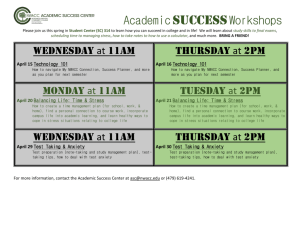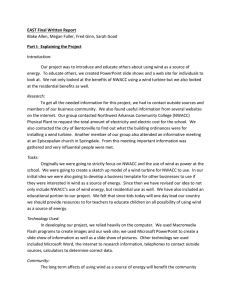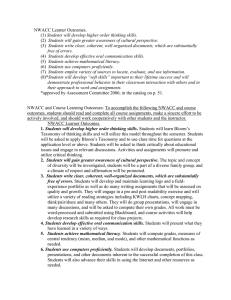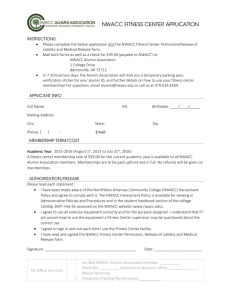Going Green on NWACC Campus
advertisement
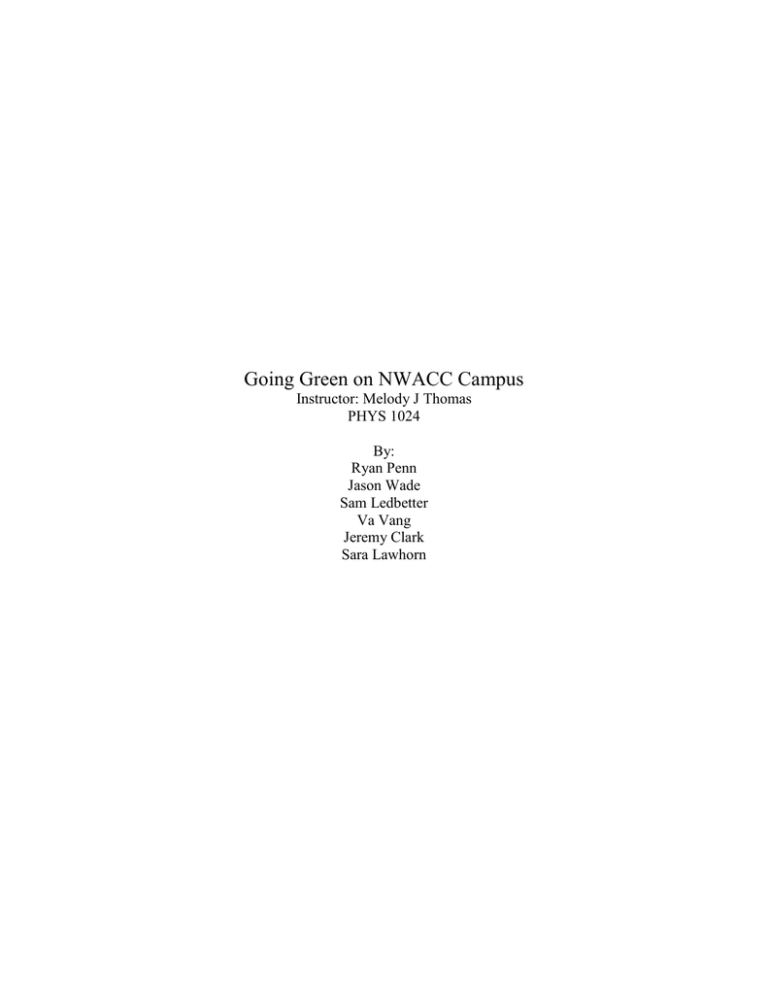
Going Green on NWACC Campus Instructor: Melody J Thomas PHYS 1024 By: Ryan Penn Jason Wade Sam Ledbetter Va Vang Jeremy Clark Sara Lawhorn As a group, we researched new ways for Northwest Arkansas Community College and the local community to save energy, while cutting cost, by becoming more ecofriendly. We researched many different options on how to reduce energy consumption that could be implemented on the NWACC campus such as LED lighting, water-free urinals, renewable energy, and numerous ways of recycling. We’ve researched the energy consumption at NWACC and have made estimates on how much money could be saved by making a few eco-friendly changes within the college. In this report, you will find how we can become more environmentally friendly while cutting cost and eventually lowering the tuition fees. LED lighting is a great way to illustrate the benefits in energy savings, maintenance costs, and the environmental impacts by going green at NWACC. Light Emitting Diode bulbs have been estimated to use 48 % less energy then the bulbs used in our classrooms. Most typical LED’s are designed to operate with no more than 30-60 milli-watts of electrical power. One of the key advantages of LED-based lighting is its high efficiency, as measured by its light output per unit power input. LED’s produce more light per watt then incandescent bulbs; which is very valuable to saving energy. LED’s are ideal for use in applications that are subject to frequent on-off cycling, unlike fluorescent lamps that burn out much quicker when cycled on and off. Currently, Northwest Arkansas Community College spends about $456, 737 a year on electricity. As a group, we feel the college can make vast improvements on saving money by switching to LED lighting for the classrooms. A recent study was done by Cree Inc., a manufacturer of LED lighting components, showed the total savings from using a CC vivid 2 watt LED light bulb over an incandescent 60 watt light bulb. After 60,000 hours of use, the total cost from an incandescent 60 watt light bulb was $400.20, compared to the $46.95 of total cost from using the LED light bulb. Cree Inc’s study has shown a difference in price of 88 % over 60,000 hours of use. Though it is hard to estimate how much NWACC would save by converting to LED lights, it’s not hard to see that the savings would be crucial. Another way to help cut costs, while being more environmentally friendly, is to implement renewable energy. Dell Computer’s 2.1 million-square-foot headquarters in Round Rock, Texas is powered entirely on renewable energy. Sixty percent of the energy is supplied by wind power and the remaining forty percent is from Waste Management’s landfill gas-to-energy plant. Dell President, Paul Bell, challenged others to follow the new energy future, “It’s time for our industry to take the lead role in creating a clean energy future. We challenge every technology company to work with their suppliers and partners in integrating green power and energy-efficient strategies into their operations.” Bell also said “We’re using green technology to drive operating expenses down.” But Dell is not alone. Such big corporations such as Wal-Mart and Sam’s Club have also implemented renewable energy operations to help lower energy cost while being more eco-friendly. An example is the Wal-Mart located in Lowell, AR; they have installed wind power turbines that are responsible for energy needed to light up the entire parking lot. We believe this would be a great idea for NWACC to consider for its parking deck, which costs $40,386 a year to run. While it is easier for big corporations to make vast improvements in energy saving strategies, it can also be done by others. St. Thomas Episcopal Church, located in Springdale off I-540, has also become more energy efficient by installing three wind turbines to generate electricity. The three turbines will generate about 500 kilowatt hours of electricity each month, which is about 15 percent of the church's current energy needs. Not only do the turbines help with costs but it will also keep about 12,000 pounds of carbon dioxide from being released into the atmosphere each year. Another great example of how “going green” can save money is water-free urinals. “An average of 40,000 gallons per urinal, per year, is saved with water-free urinals.” Besides saving water, greenhouse gases are reduced. On average, every billion gallons of water saved avoids the generation of 18 million pounds of C02. Also, Rainwater harvesting is the practice of collecting and using rainwater, most commonly from roofs. The use of collected rainwater can provide NWACC with high-quality soft water for irrigation and potable uses, reduce pressure on water-treatment plants, and reduce storm water runoff and flooding. Of course, to use as potable water, filtration and purification are necessary. Presently, NWACC spends $68,946 a year on water, which is a stifling amount. With the help of water free urinals and rainwater harvesting, we feel these cost can be drastically reduced. The lifestyle of your typical college student can generate a lot of garbage/waste and we wanted to know what other colleges are doing to be more environmentally friendly all the while saving money? “Seattle University is fertilizing flowers on campus, by using pineapple heads, watermelon rinds, and lettuce, instead of being thrown in the trash.” Warren Wilson College, in North Carolina, built an “EcoDorm” on its campus with “solar fuel that converts sunlight into electricity and heat and installed composting toilets and water-free urinals.” While some colleges are making bold steps on going green, others are taking smaller steps. Some colleges are buying inexpensive dishes, instead of buying disposable plates and cups, and washing them with filtrated rainwater. Through this project, we as a group have developed better interpersonal skills. By dividing up some of the responsibilities and project research, it showed how important these intrapersonal skills are to having a functional group. Working as a group has helped in gaining knowledge from others on the different aspects of how to present our project as a whole. We as a group, have used many different ways of research for this project. Some did a vast amount of research at our NWACC EAST lab and campus library, while others went out into the community to see how others were “going green”. For any future EAST project groups, that would like to research on how “going green” can save money, we suggest expanding on our research by providing more detailed numbers of the costs affiliated with building wind power turbines and installing LED lights and water free urinals. Not to mention, how many years it would take NWACC to turn “going green” into a money saving investment. References http://en.wikipedia.org/wiki/LED http://www.enn.com/energy/article/34251/print http://thefraserdomain.typepad.com/energy/2007 http://www.nwanews.com/nwat/news/64141/



